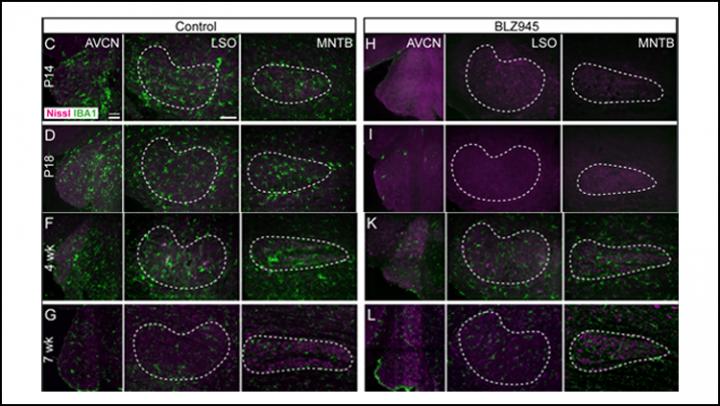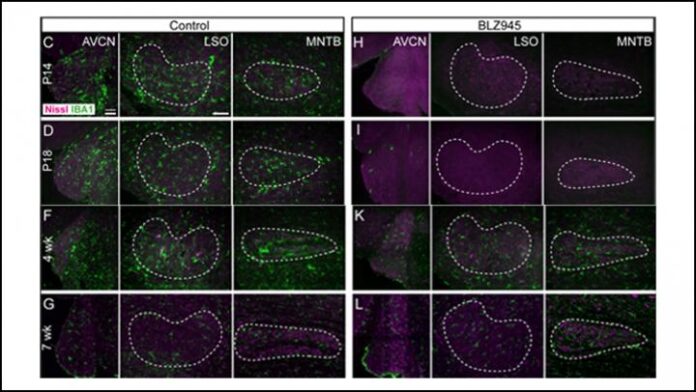[ad_1]
Summary: Microglia are essential for pruning away extra neural connections in the development of the auditory brainstem.
Source: SfN
Auditory pathways in the brainstem do not fully mature without microglia clearing away extra cell connections. This crucial function occurs even when pruning by microglia is delayed, according to new research published in eNeuro.
Sensitive hearing requires precise connections between neurons in the auditory brainstem. Early in development, support cells called microglia prune away unnecessary connections and encourage others to expand. Microglia finish their job around two weeks after birth, but the rigidity of this developmental timeframe is unknown.
Milinkeviciute et al. eliminated microglia from the brains of newborn mice using a drug. They stopped the treatment after 10 days, and microglia returned to the brainstem. Initially, the mice with delayed microglia development had more synaptic connections and less sensitive hearing than the controls.

The repopulated microglia corrected these issues by the time the mice were seven weeks old.
These results demonstrate the crucial role of microglia in hearing development, even when the timing of their activity is delayed.
About this auditory neuroscience research news
Source: SfN
Contact: Calli McMurray – SfN
Image: The image is credited to Milinkeviciute et al., eNeuro 2021.
Original Research: Closed access.
“Auditory Brainstem Deficits From Early Treatment With a CSF1R Inhibitor Largely Recover With Microglial Repopulation” by Giedre Milinkeviciute, Sima M. Chokr, and Karina S. Cramer. eNeuro
Abstract
Auditory Brainstem Deficits From Early Treatment With a CSF1R Inhibitor Largely Recover With Microglial Repopulation
Signaling between neurons and glia is necessary for the formation of functional neural circuits. A role for microglia in the maturation of connections in the medial nucleus of the trapezoid body (MNTB was previously demonstrated by postnatal microglial elimination using a colony stimulating factor 1 receptor (CSF1R). Defective pruning of calyces of Held and significant reduction of the mature astrocyte marker glial fibrillary acidic protein (GFAP) were observed after hearing onset. Here, we investigated the time course required for microglia to populate the mouse MNTB after cessation of CSF1R inhibitor treatment. We then examined whether defects seen after microglial depletion were rectified by microglial repopulation. We found that microglia returned to control levels at 4 weeks (wk) of age (18 days post cessation of treatment). Calyceal innervation of MNTB neurons was comparable to control levels at 4 wk, and GFAP expression recovered by 7 wk. We further investigated the effects of microglia elimination and repopulation on auditory function using auditory brainstem recordings (ABR). Temporary microglial depletion significantly elevated auditory thresholds in response to 4. 8, and 12 kHz at 4 wk. Treatment significantly affected latencies, interpeak latencies, and amplitudes of all the ABR peaks in response to many of the frequencies tested. These effects largely recovered by 7 wk. These findings highlight the functions of microglia in the formation of auditory neural circuits early in development. Further, the results suggest that microglia retain their developmental functions beyond the period of circuit refinement.
Significance Statement
Auditory brainstem pathways are optimized for their special functions that are shaped during development, which rely on the functions of non-neuronal cells, such as microglia and astrocytes. When microglia were pharmacologically eliminated during the early postnatal period with a CSF1R inhibitor, excess calyces were not pruned and astrocytes did not mature properly in the auditory brainstem. Here we show that once this drug is withdrawn, microglia gradually return to the auditory nuclei. After microglia re-emerge in the MNTB, synaptic pruning of calyces of Held resumes and maturation of astrocytes and auditory function recover. The findings suggest that the auditory brainstem pathways can be shaped by microglia even after their normal period of circuit development.
[ad_2]
Source link













